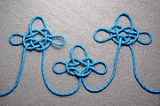
Jury mast knot
Encyclopedia
The Jury mast knot is traditionally used for jury rig
ging a temporary mast
on a sailboat
or ship
after the original one has been lost. The knot
is placed at the top of a new mast with the mast projecting through the center of the knot. The loops of the knot are then used as anchor points for makeshift stays
and shrouds
. Usually small blocks of wood are affixed to, or a groove cut in, the new mast to prevent the knot from sliding downwards.
There is contention among knot researchers whether this supposed rigging knot can work as described. Due to a lack of hard historical evidence there is also uncertainty whether it was ever commonly used for rigging jury masts.
, for the purposes of description the left side will be considered the standing part. If all the crossings and overlays are reversed, or the right side is taken as the standing part, a mirror image of the knot will result.
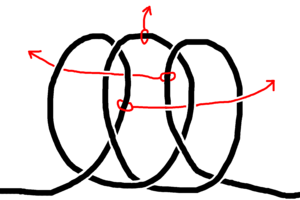
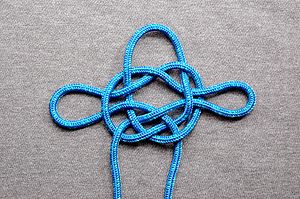
with the two free ends. The pattern of this variation, from the left, is: under-over-under/over-over.

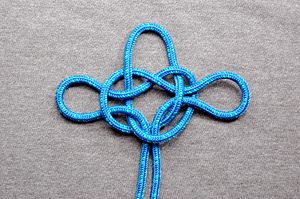
this is the preferred variation. The pattern of this variation, from the left, is: under-under-under/under-under.

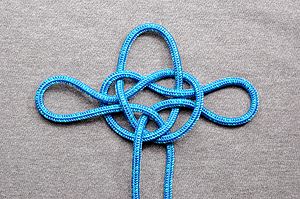
Jury rig
Jury rigging refers to makeshift repairs or temporary contrivances, made with only the tools and materials that happen to be on hand. Originally a nautical term, on sailing ships a jury rig is a replacement mast and yards improvised in case of damage or loss of the original mast.-Etymology:The...
ging a temporary mast
Mast (sailing)
The mast of a sailing vessel is a tall, vertical, or near vertical, spar, or arrangement of spars, which supports the sails. Large ships have several masts, with the size and configuration depending on the style of ship...
on a sailboat
Sailboat
A sailboat or sailing boat is a boat propelled partly or entirely by sails. The term covers a variety of boats, larger than small vessels such as sailboards and smaller than sailing ships, but distinctions in the size are not strictly defined and what constitutes a sailing ship, sailboat, or a...
or ship
Sailing ship
The term sailing ship is now used to refer to any large wind-powered vessel. In technical terms, a ship was a sailing vessel with a specific rig of at least three masts, square rigged on all of them, making the sailing adjective redundant. In popular usage "ship" became associated with all large...
after the original one has been lost. The knot
Knot
A knot is a method of fastening or securing linear material such as rope by tying or interweaving. It may consist of a length of one or several segments of rope, string, webbing, twine, strap, or even chain interwoven such that the line can bind to itself or to some other object—the "load"...
is placed at the top of a new mast with the mast projecting through the center of the knot. The loops of the knot are then used as anchor points for makeshift stays
Stays (nautical)
Stays are the heavy ropes, wires, or rods on sailing vessels that run from the masts to the hull, usually fore-and-aft along the centerline of the vessel...
and shrouds
Shroud (sailing)
On a sailboat, the shrouds are pieces of standing rigging which hold the mast up from side to side. There is frequently more than one shroud on each side of the boat....
. Usually small blocks of wood are affixed to, or a groove cut in, the new mast to prevent the knot from sliding downwards.
There is contention among knot researchers whether this supposed rigging knot can work as described. Due to a lack of hard historical evidence there is also uncertainty whether it was ever commonly used for rigging jury masts.
Variations
There are three closely related variations of this knot. They differ based on the type of crossing, overhand or underhand, of the three initial loops and then whether the edges of each loop is positioned over or under the previous one. Although these knots are tied in the bightBight (knot)
In knot tying, a bight is a curved section, slack part, or loop between the two ends of a rope, string, or yarn. The term is also used in a more specific way when describing Turk's head knots, indicating how many repetitions of braiding are made in the circuit of a given knot.-Slipped knot:In order...
, for the purposes of description the left side will be considered the standing part. If all the crossings and overlays are reversed, or the right side is taken as the standing part, a mirror image of the knot will result.
#1167
This variation grips the mast best in the absence of other means to prevent the knot from sliding downwards. The pattern of this variation, from the left, is: under-under-under/over-over.

#1168
This variation is the simplest of the three in structure (though not in tying) and lends itself to being reinforced by tying a reef knotReef knot
The reef knot or square knot is an ancient and simple binding knot used to secure a rope or line around an object. Although the reef knot is often seen used for tying two ropes together, it is not recommended for this purpose due to potential instability of the knot.A reef knot is formed by tying...
with the two free ends. The pattern of this variation, from the left, is: under-over-under/over-over.


#1169
According to Clifford AshleyClifford Ashley
Clifford Warren Ashley was an American artist, author, sailor, and knot expert. He was born in New Bedford, Massachusetts, son of Abiel Davis Ashley and Caroline Morse. Ashley married Sarah Scudder Clark in 1932 and had two daughters, also adopting his wife's oldest daughter from a previous...
this is the preferred variation. The pattern of this variation, from the left, is: under-under-under/under-under.



